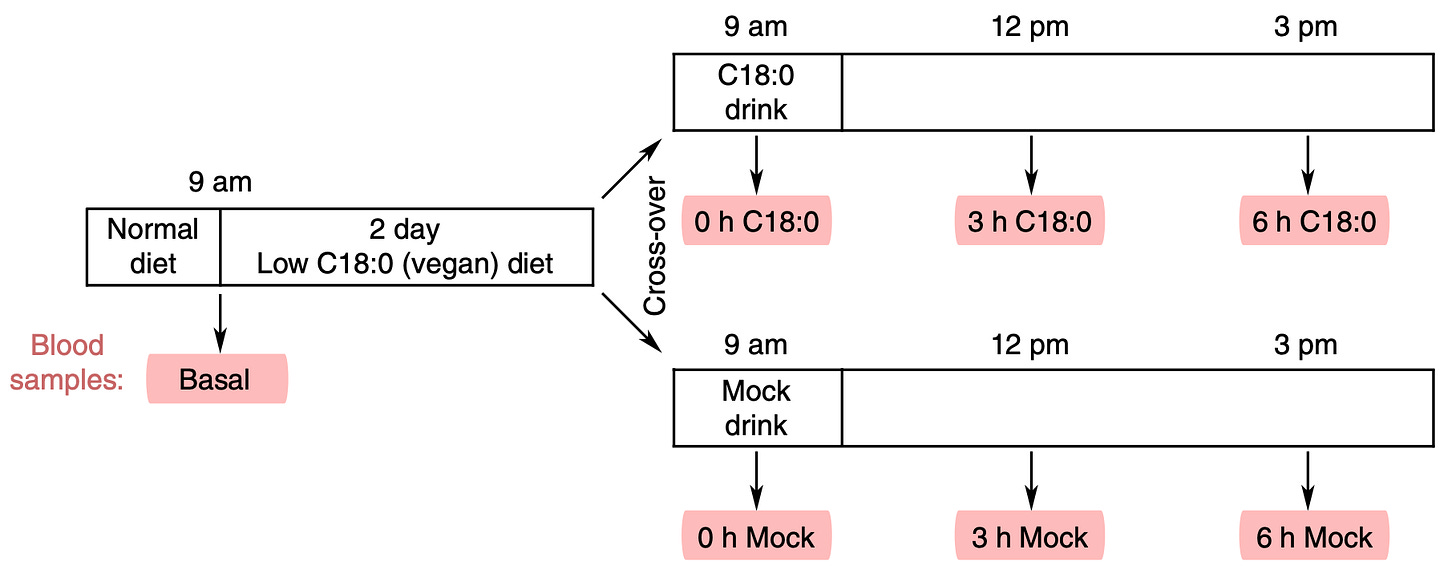This Saturated Fat Can Burn Fat: A Milkshake Experiment
Saturated fats are often lumped together as one homogenous entity. They are not. Stearic acid increases mitochondrial fusion and β-oxidation in a controlled human study. Why does this matter?
Saturated fat is one of the most misunderstood nutrients in nutrition. Part of this misunderstanding stems from a stereotype: Saturated fats are often lumped together as one homogenous entity. But they are not.
Lumping saturated fats as a single article and labeling them “dangerous” is the same as lumping all felines into a group and calling them dangerous—even though a tiger could rip your head off with a swipe of its paw and a kitty is only dangerous insofar as its cuteness factor could be off the scale.
In this letter, I’m going to prove the point by reviewing data showing how one saturated fat, stearic acid, positively influences metabolism to increase fat burning at the mitochondrial level.
I will also provide you a boarder evolutionary framework in which to understand these data, give you practical takeaways, including where to get this stearic acid from your diet. And I’ll speak to its other health benefits, including its potential in reducing visceral fat, protecting the brain, and fighting colon cancer.
Let’s dig in.
Stearic acid and it’s Cousin
Stearic acid is an 18-carbon saturated fat found in certain animal fats and chocolate. Because it’s saturated, it has all single bonds and looks, biochemically, like an unassuming molecular stick composed of hydrogens and carbons—just two carbons longer than it’s cousin, the 16-carbon saturated fat, palmitic acid.
Stearic Acid: A Milkshake Study
The study in question set out to investigate the differential effects of these saturated fats on metabolism, particularly on mitochondrial function.
So, they took a diverse group of individuals—including those who were healthy and those with type 2 diabetes—and started by placing them on a low-fat vegan diet for two days in order to reduce their saturated fat and stearic acid intake.
Then, they gave these people milkshakes. Yes—they gave them banana milkshakes! One was a control milkshake (“Mock”), and the other contained 24 g of stearic acid (“C18:0 drink”). What happened next is pretty cool...
Stearic Acid Milkshake Increases Mitochondrial Fusion
They looked at the participants’ mitochondria 3 and 6 hours after consuming the stearic acid “C18:0” milkshake or the “Mock” control, and saw that stearic acid caused the mitochondria to fuse together. Red marks mitochondria in circulating white blood cells.
When given stearic acid, the percentage of fused mitochondria increases ~4-fold. This did not happen with the control drink.
*Nuance Note 1: In the human study, they used circulating cells (neutrophils) because collecting them was minimally invasive. If we are to conclude that stearic acid has a large influences whole body metabolism, we’d need to assume that this impact on mitochondrial morphology generalizes to other tissues, e.g. muscle cells. Based on prior tissue culture work, including with human cells, this appears to be a reasonable assumption.
If you want a pop-culture analogy, think of it like assembling the Avengers. Individually, they’re impressive, but together, they’re more powerful. In fusing, the mitochondria become temporarily more efficient and productive.
By contrast, stearic acid restriction in the form of the low stearic acid vegan diet caused mitochondria to fracture and fragment. (More on the long-term effects later).
Higher Circulating Stearic Acid is Associated with Mitochondrial Fusion
They also found an association between increased levels of stearic acid in the blood and increased mitochondrial fusion.
This association was specific to stearic acid—not to palmitic acid or other molecules assayed (cholesterol, glucose, insulin, methylglyoxal, iron, ferritin, transferrin, and hepcidin).
The researchers also did experiments with isolated stearic acid, palmitic acid controls, and replicated their findings under various conditions to show it was indeed stearic acid causing mitochondrial fusion.
Stearic Acid Increases Markers of β-Oxidation (“Fat Burning”)
What were the consequences?
In parallel with mitochondrial fusion, there were signs of increased fat burning by mitochondria, as assessed by changes in levels of acylcarnitines.
*Nuance Note 2: Acylcarnitines are fatty acids bound to carnitine, which is required for the import of long-chain fatty acids into mitochondria so they can undergo β-oxidation—the biochemical pathway by which fat is burned. I’ve drawn out the “carnitine shuttle” (rate my handwriting? Tried my best!) for your interests. Basically, long-chain fatty acids needs to undergo a series of chemical transformations to get into the innermost part of the mitochondria, where β-oxidation occurs. The highlights allow you to trace the path of the fatty acid, like stearic acid.
Nuance Note 2, continued: When β-oxidation is impaired relative to fatty acid availability (i.e., fat burning is inhibited), these acylcarnitines accumulate. Conversely, an increase in β-oxidation (fat burning) can cause a drop in these long-chain acylcarnitines, as was seen in this paper with stearic acid supplementation.
SIMPLY (hope I didn’t lose you), this means…
The data show that stearic acid changes mitochondrial dynamics to increase fat burning in mitochondria after feeding.
But WHY?
In the rest of this letter, we will discuss:
An Evolutionary Framework for Understanding these Data
Specific Dietary Sources of Stearic Acid
Other Benefits: Visceral Fat
Other Benefits: Blood Pressure & Blood Clots
Other Benefits: Oxidative Stress
Other Benefits: Neuroprotection
Other Benefits: Cancers
The Symphony of Saturated fat
Keep reading with a 7-day free trial
Subscribe to Nicholas’s Substack to keep reading this post and get 7 days of free access to the full post archives.









